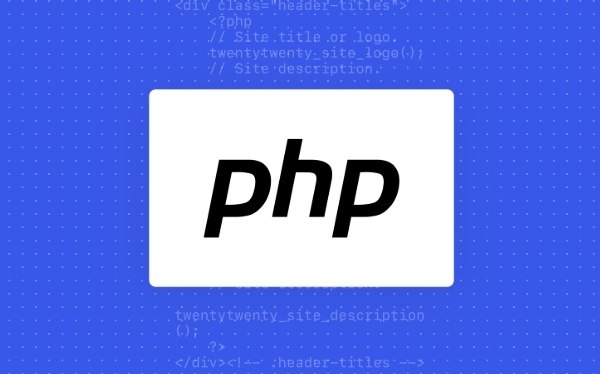To define a function that accepts referenced parameters in PHP, you need to prepend the parameter with &: function increment(&$number) { $number ; } when defining the function. 1. When defining a function, add the & symbol before the parameter name to enable reference passing; 2. When calling the function, do not need to add &, just pass in the variable directly; 3. Do not use reference passing on the literal, otherwise an error will be reported; 4. Reference passing is suitable for situations where external variables need to be modified, but abuse should be avoided to keep the code clear; 5. PHP also supports returning references, but should be used with caution. For example, after calling increment($num), the value of $num will be modified internally by the function and preserved externally.

In PHP, by default, the parameters of the function are passed by value, which means that the modification of the variables inside the function will not affect the original variables outside. But if you want the function to modify the variables passed in and these modifications can be reflected outside the function, you need to use pass by reference .

PHP allows you to specify that the parameter is passed in reference by preceding the parameter by specifying the & symbol when defining a function.

How to define a function that accepts referenced parameters?
When defining a function, add & before the parameter name:
function increment(&$number) {
$number ;
}When called in this way, the variables passed in will be treated as references:

$num = 5; increment($num); echo $num; // Output 6
As you can see, the value of $num is changed in the function, and this change is retained outside the function.
What should be noted is:
- Reference passes must be declared when the function is defined and cannot be temporarily decided upon when the call is called.
- It is not recommended to pass references to literals (such as numbers and direct strings) as an error will be triggered.
How to correctly use reference parameters when calling a function
When calling a function, you do not need to add & before the parameters, you only need to make sure that the reference parameters have been declared in the function definition.
$value = 10; increment($value); // Correct: no need to add & when calling
But if you see a writing method like this in the old version of PHP code:
increment(&$value); // Obsolete writing
This was intended to explicitly referencing passes in earlier versions, but was no longer needed in PHP 5 and later, and this writing is now considered outdated and may even report an error.
Common misunderstandings and precautions
Not all parameters need to be passed by reference
If you just want to read the value of a variable instead of modifying it, there is no need to use a reference. Abuse of references will make the code difficult to understand and maintain.Will reference passes affect performance?
Generally speaking, reference passes can save memory, especially when dealing with large arrays or objects. However, PHP has been optimized internally (such as copy-on-write), so in most cases, there is no need to deliberately use references to improve performance.Returning a quote is also feasible
In addition to parameters, PHP also supports returning references, but this is more complicated and you need to be particularly careful when using it. For example:function &getReference() { static $var = 0; return $var; } $ref = &getReference(); $ref = 10; echo getReference(); // Output 10
Summarize
The key to implementing reference parameter transfer in PHP is to add
&to the parameter when the function is defined. This method is suitable for situations where you need to modify external variables inside the function. Be careful not to abuse it, keeping the code clear and secure is more important.Basically that's it.
The above is the detailed content of How to pass arguments by reference in a PHP function?. For more information, please follow other related articles on the PHP Chinese website!

Hot AI Tools

Undress AI Tool
Undress images for free

Undresser.AI Undress
AI-powered app for creating realistic nude photos

AI Clothes Remover
Online AI tool for removing clothes from photos.

Clothoff.io
AI clothes remover

Video Face Swap
Swap faces in any video effortlessly with our completely free AI face swap tool!

Hot Article

Hot Tools

Notepad++7.3.1
Easy-to-use and free code editor

SublimeText3 Chinese version
Chinese version, very easy to use

Zend Studio 13.0.1
Powerful PHP integrated development environment

Dreamweaver CS6
Visual web development tools

SublimeText3 Mac version
God-level code editing software (SublimeText3)

Hot Topics
 How do I implement authentication and authorization in PHP?
Jun 20, 2025 am 01:03 AM
How do I implement authentication and authorization in PHP?
Jun 20, 2025 am 01:03 AM
TosecurelyhandleauthenticationandauthorizationinPHP,followthesesteps:1.Alwayshashpasswordswithpassword_hash()andverifyusingpassword_verify(),usepreparedstatementstopreventSQLinjection,andstoreuserdatain$_SESSIONafterlogin.2.Implementrole-basedaccessc
 How can you handle file uploads securely in PHP?
Jun 19, 2025 am 01:05 AM
How can you handle file uploads securely in PHP?
Jun 19, 2025 am 01:05 AM
To safely handle file uploads in PHP, the core is to verify file types, rename files, and restrict permissions. 1. Use finfo_file() to check the real MIME type, and only specific types such as image/jpeg are allowed; 2. Use uniqid() to generate random file names and store them in non-Web root directory; 3. Limit file size through php.ini and HTML forms, and set directory permissions to 0755; 4. Use ClamAV to scan malware to enhance security. These steps effectively prevent security vulnerabilities and ensure that the file upload process is safe and reliable.
 What are the differences between == (loose comparison) and === (strict comparison) in PHP?
Jun 19, 2025 am 01:07 AM
What are the differences between == (loose comparison) and === (strict comparison) in PHP?
Jun 19, 2025 am 01:07 AM
In PHP, the main difference between == and == is the strictness of type checking. ==Type conversion will be performed before comparison, for example, 5=="5" returns true, and ===Request that the value and type are the same before true will be returned, for example, 5==="5" returns false. In usage scenarios, === is more secure and should be used first, and == is only used when type conversion is required.
 How do I perform arithmetic operations in PHP ( , -, *, /, %)?
Jun 19, 2025 pm 05:13 PM
How do I perform arithmetic operations in PHP ( , -, *, /, %)?
Jun 19, 2025 pm 05:13 PM
The methods of using basic mathematical operations in PHP are as follows: 1. Addition signs support integers and floating-point numbers, and can also be used for variables. String numbers will be automatically converted but not recommended to dependencies; 2. Subtraction signs use - signs, variables are the same, and type conversion is also applicable; 3. Multiplication signs use * signs, which are suitable for numbers and similar strings; 4. Division uses / signs, which need to avoid dividing by zero, and note that the result may be floating-point numbers; 5. Taking the modulus signs can be used to judge odd and even numbers, and when processing negative numbers, the remainder signs are consistent with the dividend. The key to using these operators correctly is to ensure that the data types are clear and the boundary situation is handled well.
 How can you interact with NoSQL databases (e.g., MongoDB, Redis) from PHP?
Jun 19, 2025 am 01:07 AM
How can you interact with NoSQL databases (e.g., MongoDB, Redis) from PHP?
Jun 19, 2025 am 01:07 AM
Yes, PHP can interact with NoSQL databases like MongoDB and Redis through specific extensions or libraries. First, use the MongoDBPHP driver (installed through PECL or Composer) to create client instances and operate databases and collections, supporting insertion, query, aggregation and other operations; second, use the Predis library or phpredis extension to connect to Redis, perform key-value settings and acquisitions, and recommend phpredis for high-performance scenarios, while Predis is convenient for rapid deployment; both are suitable for production environments and are well-documented.
 How do I stay up-to-date with the latest PHP developments and best practices?
Jun 23, 2025 am 12:56 AM
How do I stay up-to-date with the latest PHP developments and best practices?
Jun 23, 2025 am 12:56 AM
TostaycurrentwithPHPdevelopmentsandbestpractices,followkeynewssourceslikePHP.netandPHPWeekly,engagewithcommunitiesonforumsandconferences,keeptoolingupdatedandgraduallyadoptnewfeatures,andreadorcontributetoopensourceprojects.First,followreliablesource
 What is PHP, and why is it used for web development?
Jun 23, 2025 am 12:55 AM
What is PHP, and why is it used for web development?
Jun 23, 2025 am 12:55 AM
PHPbecamepopularforwebdevelopmentduetoitseaseoflearning,seamlessintegrationwithHTML,widespreadhostingsupport,andalargeecosystemincludingframeworkslikeLaravelandCMSplatformslikeWordPress.Itexcelsinhandlingformsubmissions,managingusersessions,interacti
 How to set PHP time zone?
Jun 25, 2025 am 01:00 AM
How to set PHP time zone?
Jun 25, 2025 am 01:00 AM
TosettherighttimezoneinPHP,usedate_default_timezone_set()functionatthestartofyourscriptwithavalididentifiersuchas'America/New_York'.1.Usedate_default_timezone_set()beforeanydate/timefunctions.2.Alternatively,configurethephp.inifilebysettingdate.timez






